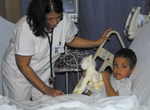New procedure avoids open-heart surgery
by Michael BakerPublic Relations
Pediatric cardiologists brightened the life of another child last week when Wolfgang Radtke, M.D., and Rani Bandisode, M.D., performed a rare procedure to repair a hole in a young boy’s heart.
MUSC serves as one of only seven medical centers in the United States currently participating in a Phase-I trial approved by the FDA.
 Dr.
Rani Bandisode examines Thomas Gass, 6, in the Children’s Hospital. Thomas
underwent a procedure to repair a hole in the lower chamber of his heart.
Dr.
Rani Bandisode examines Thomas Gass, 6, in the Children’s Hospital. Thomas
underwent a procedure to repair a hole in the lower chamber of his heart.
On Jan. 20, 6-year-old Thomas Gass came from Greenville to receive treatment for a ventricular septal defect—a hole between the right and left pumping chambers in the lower region of his heart.
Radtke and Bandisode performed an innovative procedure marked by a departure from typical open-heart surgery.
Rather than working making an incision in the chest, Radtke and Bandisode inserted a catheter into a vein in Thomas’s thigh. Then, they ran the catheter up through the vein and into the heart until reaching the septal hole. Once the catheter was in place, Radtke and Bandisode positioned a device—called an Amplatzer—to block the hole.
Positioned properly, the Amplatzer works by unfolding itself and sealing the open area between the ventricles. The device is composed of two wire mesh discs that, once implanted, block the hole while allowing the heart’s tissue to grow around the Amplatzer.
In this way, the ventricular wall builds itself around the foundation of the Amplatzer.
In addition to substituting for more invasive open-heart surgery, the catheter-based procedure affords patients a much shorter recovery time. Bandisode and Radtke performed the procedure on a Tuesday morning, and Thomas left the hospital on Wednesday afternoon.
Such benefits provide a measure of added comfort for the patient, but the procedure’s effectiveness remains its most important characteristic.
Bandisode explained that the hole in Thomas’s heart sat directly below a crucial valve; similar scenarios proved resistant to treatments in the past.
“Other attempts at plugging holes in similar locations within the heart were unsuccessful,” she said. “In each case, the procedure affected the valve’s functional competence, compromising the proper circulation of blood throughout the heart.”
In Thomas’s case, however, Radtke and Bandisode implanted the Amplatzer without affecting the neighboring valve in any way. The operation stands as the first such endeavor to be successfully completed in the Southeast.
The timing of the procedure also was very important, according to Radtke.
“The defect forced Thomas’s heart to work almost twice as hard as it should have,” he explained. “At his age, Thomas could tolerate the strain, but later in life, he would have experienced significant trouble.”
With the Amplatzer firmly in place, Thomas returned to Greenville the day after his operation. Meanwhile, Radtke and Bandisode performs four more Amplatzer operations during the remainder of the week.
Helping children remains the mission of any pediatric cardiology unit. But with the help of innovative procedures and new technology, MUSC continues to make strides toward gentler, more efficient patient care
Catalyst Online is published weekly, updated as
needed and improved from time to time by the MUSC Office of Public Relations
for the faculty, employees and students of the Medical University of South
Carolina. Catalyst Online editor, Kim Draughn, can be reached at 792-4107
or by email, catalyst@musc.edu. Editorial copy can be submitted to Catalyst
Online and to The Catalyst in print by fax, 792-6723, or by email to petersnd@musc.edu
or catalyst@musc.edu. To place an ad in The Catalyst hardcopy, call Community
Press at 849-1778.